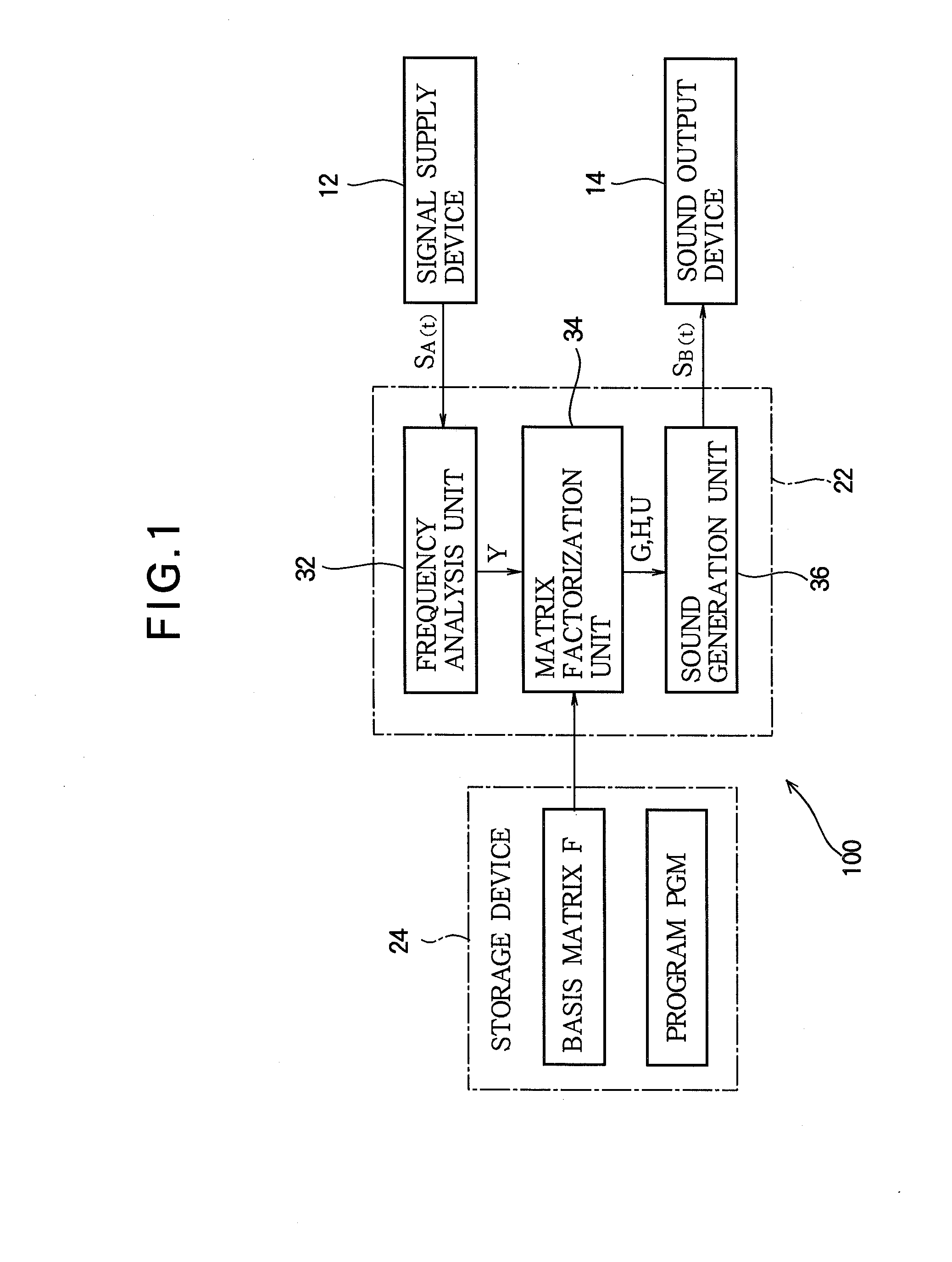Sound Processing Apparatus
a technology of sound processing and sound source, which is applied in the field of sound processing apparatus, can solve the problems of high accuracy and difficulty in accurately separating (clustering) the mixed sound of a plurality of sounds by respective sound sources
- Summary
- Abstract
- Description
- Claims
- Application Information
AI Technical Summary
Benefits of technology
Problems solved by technology
Method used
Image
Examples
first embodiment
[0028]FIG. 1 is a block diagram of a sound processing apparatus 100 according to a first embodiment of the present invention. Referring to FIG. 1, the sound processing apparatus 100 is connected to a signal supply device 12 and a sound output device 14. The signal supply device 12 supplies a sound signal SA(t) to the sound processing apparatus 100. The sound signal SA(t) represents the time waveform of a mixed sound composed of sounds (musical tones or voices) respectively generated from different sound sources. Hereinafter, a known sound source from among a plurality of sound sources which generate sounds constituting the sound signal SA(t) is referred to as a first sound source and a sound source other than the first sound source is referred to as a second sound source. When the sound signal SA(t) is composed of sounds generated from two sound sources, the second sound source corresponds to the sound source other than the first sound source. When the sound signal SA(t) is composed...
second embodiment
[0058]A second embodiment of the invention will now be described. In each embodiment illustrated below, elements whose operations or functions are similar to those of the first embodiment will be denoted by the same reference numerals as used in the above description and a detailed description thereof will be omitted as appropriate.
[0059]In the first embodiment, the basis vector h[d] of the basis matrix H computed by the matrix factorization unit 34 may become equal to the basis vector f[k] of the known basis matrix F because the correlation between the basis matrix F of the first sound source and the basis matrix H of the second sound source is not confined. When the basis vector h[d] corresponds to the basis vector f[k], one of the coefficient vector g[k] of the coefficient matrix G and the coefficient vector u[d] of the coefficient matrix U converges into a zero vector in order to establish expression (2). However, a sound component of the first sound source, which corresponds to...
third embodiment
[0072]In the evaluation function J of expression (3A) exemplified in the second embodiment, the values of the error term ∥Y−FG−HU∥Fr2 and correlation term ∥FTH∥Fr2 may be considerably different from each other. That is, degrees of contribution of the error term and correlation term to increase / decrease of the evaluation function J can remarkably differ from each other. For example, when the error term is remarkably larger than the correlation term, the evaluation function J is sufficiently reduced if the error term decreases, and thus there is a possibility that the correlation term is not sufficiently reduced. Similarly, the error term may not sufficiently decrease if the correlation term is considerably larger than the error term.
[0073]Accordingly, in the third embodiment, the error term and the correlation term of the evaluation function J approximate each other. Specifically, an evaluation function K represented as the following expression (3B), which is obtained by adding a pre...
PUM
 Login to View More
Login to View More Abstract
Description
Claims
Application Information
 Login to View More
Login to View More - R&D
- Intellectual Property
- Life Sciences
- Materials
- Tech Scout
- Unparalleled Data Quality
- Higher Quality Content
- 60% Fewer Hallucinations
Browse by: Latest US Patents, China's latest patents, Technical Efficacy Thesaurus, Application Domain, Technology Topic, Popular Technical Reports.
© 2025 PatSnap. All rights reserved.Legal|Privacy policy|Modern Slavery Act Transparency Statement|Sitemap|About US| Contact US: help@patsnap.com



